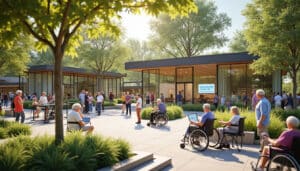The silver economy is booming, revealing major economic potential. The aging population worldwide is redefining markets and creating new opportunities. This phenomenon is profoundly transforming traditional sectors such as health and tourism.
Today, many companies are innovating to meet the specific needs of seniors. Tailored services and consumer products are evolving, opening up unparalleled growth prospects. The silver economy is thus becoming an essential driver for a sustainable future. This development invites investors and entrepreneurs to rethink their strategies to take advantage of this dynamic.
With an ever-increasing elderly population, markets are turning to innovative solutions. Cutting-edge technologies, such as robotics and digital applications, are emerging to enhance the quality of life for older individuals. Meanwhile, the beauty and health sectors are experiencing rapid transformation, offering products and services specifically designed to meet the expectations of seniors.
Investors now recognize the immense potential of the silver economy. Investment opportunities are multiplying in various fields, ranging from cultural tourism to home automation solutions for well-being at home. This evolution paves the way for sustained economic growth, driven by increasing demand and constant innovation.
Furthermore, public policies play a crucial role in supporting this burgeoning economy. Government initiatives aim to encourage sustainable development and social inclusion of seniors, fostering an environment conducive to innovation and growth. The Chinese Research Center on aging, for instance, is working to identify best practices to maximize the benefits of this demographic trend.
The longevity economy is also based on strategic principles that address key areas such as financial stability, health, education, and social connections. These principles provide a solid framework to anticipate future needs and adapt offerings accordingly. Thus, the silver economy is not limited to an economic opportunity but also contributes to a more inclusive and resilient society.
What is the silver economy and why is it important?
The silver economy refers to all economic activities related to the needs and consumption of older individuals, typically over 60 years old. This sector emerges as a proactive response to the rapid aging of populations in many countries, particularly in China, India, and several Western nations. With increasing life expectancy and declining birth rates, the proportion of older people within society is growing significantly.
This demographic shift creates new economic opportunities, ranging from health and wellness to accessible technology, including senior tourism. The silver economy encompasses not only spending but also innovation and the creation of new services and products aimed at improving the quality of life for seniors. According to the Chinese Research Center on Aging, the silver economy in China is expected to reach a substantial value by 2024, highlighting its crucial role in the national economy.
Moreover, the importance of the silver economy lies in its ability to stimulate economic growth while strengthening social bonds. By addressing the specific needs of older individuals, companies can not only generate profits but also contribute to a more inclusive and supportive society. This sector thus represents considerable potential that should not be overlooked by businesses and investors looking to adapt to demographic changes.
What are the main drivers of the silver economy?
The increase in life expectancy is the main driver of the silver economy. Thanks to medical advances and better living conditions, populations are living longer, which generates an increased demand for products and services tailored to seniors. This demographic trend creates a solid foundation for the development of various economic sectors.
Another key factor is the changing consumption needs. Older individuals seek specific solutions ranging from personalized healthcare to technologies that facilitate daily life. For instance, the home automation sector is rapidly growing to offer smart homes tailored to the needs of seniors. Similarly, accessible transportation services and targeted recreational programs respond to this growing demand.
Government policies also play a decisive role in supporting and stimulating the silver economy. Initiatives such as personalized autonomy allowances or subsidies for innovative businesses encourage the development of solutions tailored to seniors. For example, in China, in-depth exchange sessions have improved the systems for the care of older persons, thereby fostering the growth of the silver economy. These combined factors create an environment conducive to growth and innovation in this sector.
Which sectors benefit most from the silver economy?
The silver economy impacts many sectors, but some particularly benefit. The first is the health and wellness sector. With a growing elderly population, the demand for specialized medical services, health equipment, and wellness products is increasing. Companies are investing in advanced technologies like telemedicine and smart medical devices to meet these needs.
Accessible tourism is another booming field. Tourist destinations are developing infrastructures and activities specifically designed for seniors, such as accessible accommodations and adapted cultural programs. In China, for instance, the silver economy is stimulating the development of cultural tourism and senior-friendly offerings, opening new opportunities for enriching and comfortable travels. These initiatives allow for the creation of unique travel experiences that meet the expectations of older individuals.
Technologies and innovations play a crucial role in developing solutions tailored to the needs of seniors. Mobile applications for health management and home assistance robots are technological innovations that facilitate the daily lives of older individuals. Additionally, the financial services sector is adapting by offering customized savings and retirement products that cater to the specific needs of this age group. These continually evolving sectors are fundamental pillars of the silver economy, enabling sustainable and inclusive growth.
How can businesses capitalize on the silver economy?
To capitalize on the silver economy, businesses must adopt specific and innovative strategies. The first step is to innovate in products and services. This means developing offerings that directly meet the needs of seniors, such as ergonomic devices, personalized health services, or mobility solutions. For example, technology companies can create applications that simplify everyday life for older people, while tourism companies can offer circuits specially designed for the comfort and interests of seniors.
Next, it is crucial to adapt distribution channels. Companies must ensure that their products and services are easily accessible to seniors. This may include simplified online platforms, adapted physical points of sale, or home delivery services. For instance, China emphasizes coupons and the silver economy to invigorate tourism by making offers more accessible and attractive to seniors.
Targeted marketing is also essential. Businesses must use appropriate communication strategies, highlighting the specific benefits of their products for seniors. Utilizing communication channels favored by this age group, such as television or newsletters, can also increase the effectiveness of marketing campaigns. Furthermore, collaborating with organizations dedicated to seniors can enhance the credibility and relevance of the proposed offerings. These strategies enable businesses to position themselves advantageously in the silver economy market and maximize their growth opportunities.
What challenges must be overcome to develop the silver economy?
The development of the silver economy is not without challenges. One of the main obstacles is financing and willingness to pay. Companies must find a balance between the costs of developing tailored products and the willingness of seniors to spend on these novelties. According to the Médéric Alzheimer Foundation, funding for dependency and autonomy raises crucial questions about resource allocation and the sustainability of support systems.
Inclusion and accessibility also represent major challenges. It is essential to design products and services that are genuinely accessible and usable by seniors, regardless of their technological proficiency or physical abilities. This requires a user-centered approach, with thorough testing and continuous feedback from older users to improve offerings.
Managing dependency is another critical issue. With a growing elderly population, the demand for long-term care services is increasing, raising questions about the quality and accessibility of those services. Companies must invest in innovative solutions to manage this dependency while ensuring an optimal quality of life for seniors. Additionally, legislative and regulatory aspects can complicate the development of the silver economy, necessitating close collaboration between businesses, governments, and social organizations to create a favorable framework for the growth of the sector.
The impact of the silver economy on cultural tourism and seniors
The silver economy has a significant impact on the cultural tourism sector, particularly in China and India, where the aging population creates an increased demand for tailored offerings. Tourist destinations are developing specific infrastructures, such as accessible cultural centers, organized travel programs, and adapted transport services, to attract seniors. For example, China relies on coupons and the silver economy to energize tourism by offering special deals and cultural attractions that meet the needs and preferences of older individuals.
In India, the rise of the silver economy is leading to the creation of innovative start-ups and centers dedicated to dementia, thus facilitating the development of secure and enriching tourist stays for seniors. These initiatives help redefine cultural tourism by integrating elements of well-being and safety, essential for an aging population.
Case studies show how destinations can transform to become more welcoming for seniors. For instance, some regions have developed programs for b







